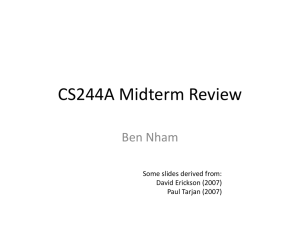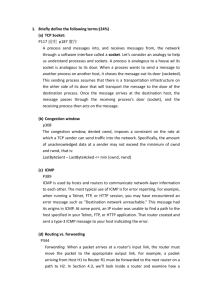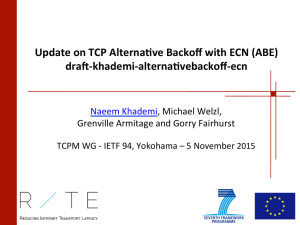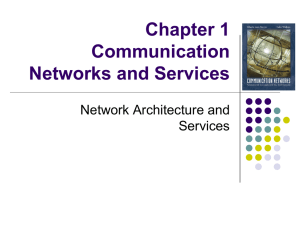TDTS21 Advanced Networking High-level summary … Niklas Carlsson, Associate Professor
advertisement
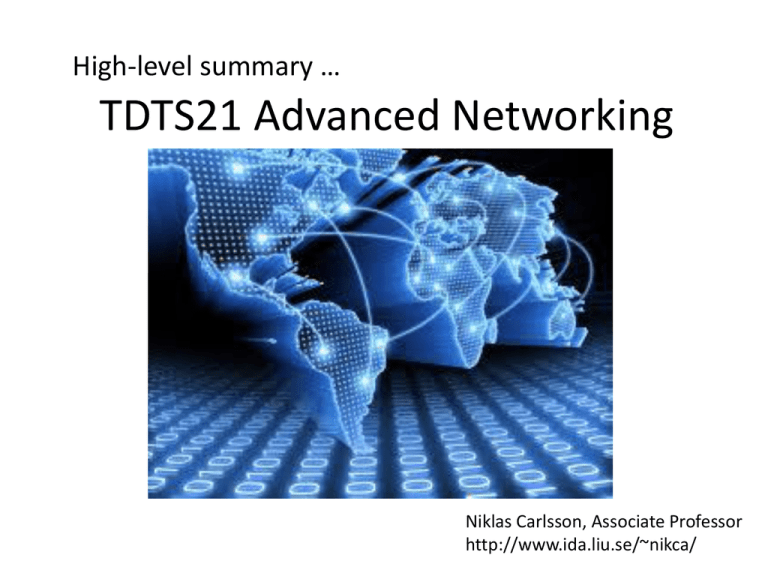
High-level summary … TDTS21 Advanced Networking Niklas Carlsson, Associate Professor http://www.ida.liu.se/~nikca/ Kick starting science ... … well, cable into wall … What happens there? Hosts, the Internet architecture, and the E2E arguments … End hosts … The Host How to find who to talk to? Learning a Host’s Address me you adapter adapter • Who am I? – Hard-wired: MAC address – Static configuration: IP interface configuration – Dynamically learned: IP address configured by DHCP • Who are you? – Hard-wired: IP address in a URL, or in the code – Dynamically looked up: ARP or DNS 10 Goals of the Internet Architecture (Clark ‘88) 1. 2. 3. 4. 5. 6. 7. 8. Connect existing networks Robust in face of failures (not nuclear war…) Support multiple types of services Accommodate a variety of networks Allow distributed management Easy host attachment Cost effective Allow resource accountability 12 Real Goals 1. 2. 3. 4. 5. 6. 7. 8. 9. Something that works….. Connect existing networks Survivability (not nuclear war…) Support multiple types of services Accommodate a variety of networks Allow distributed management Easy host attachment Cost effective Allow resource accountability 13 Host-Network Division of Labor • Network – Best-effort packet delivery – Between two (or more) end-point addresses • Hosts – Everything else host host network 14 Network Stack in Practice Host 1 Switch Host 2 Application Application Presentation Presentation Session FTP Client Video Client Video Server Session FTP Server UDP Transport TCP Network IP Data Link Ethernet 802.11n Physical UDP Transport TCP Network IP Data Link Ethernet 802.11n Physical Network IP Data Link Ethernet 802.11n Physical 15 Encapsulation, Revisited TCP Header HTTP Header Web Page Web Server HTTP Header Web Page TCP Web Page IP TCP Segment IP Header TCP Header HTTP Header IP Datagram Ethernet Header IP Header TCP Header HTTP Header Ethernet Frame Web Page Ethernet Trailer Ethernet 16 The Hourglass HTTP, FTP, RTP, IMAP, Jabber, … TCP, UDP, ICMP IPv4 Ethernet, 802.11x, DOCSIS, … Fiber, Coax, Twisted Pair, Radio, … 17 Orthogonal Planes Control plane: How Internet paths are established Application Presentation Session Transport IP Data Link Physical BGP RIP OSPF Control Plane 18 Orthogonal Planes Data plane: How data is forwarded over Internet paths Host 1 Application Transport Network Data Link Routers and Switch(es) Host 2 Network Data Link Application Transport Network Data Link 19 Reality Check • The layered abstraction is very nice • Does it hold in reality? No. Firewalls Analyze application layer headers Transparent Proxies Simulate application endpoints within the network NATs Break end-to-end network reachability 20 Holding the Internet Together • Distributed cooperation for resource allocation – BGP: what end-to-end paths to take (for ~50K ASes) – TCP: what rate to send over each path (for ~3B hosts) AS 2 AS 1 AS 3 AS 4 22 How do we find a path? Routing on a Graph 24 • Goal: determine a “good” path through the network from source to destination • What is a good path? 5 – Usually means the shortest path 3 B – Load balanced 2 – Lowest $$$ cost 2 A • Network modeled as a graph – Routers nodes – Link edges 1 • Edge cost: delay, congestion level, etc. D 1 C 5 1 3 E F 2 Intra-domain Routing Protocols • Distance vector – Routing Information Protocol (RIP), based on Bellman-Ford – Routers periodically exchange reachability info with neighbors • Link state – Open Shortest Path First (OSPF), based on Dijkstra – Each network periodically floods neighbor information to all routers – Routers locally compute routes Message Complexity Time Complexity Convergence Time Link State Distance Vector O(n2*e) O(d*n*k) O(n*log n) O(n) O(1) O(k) Robustness • Nodes may advertise • Nodes may advertise incorrect incorrect link costs path cost • Each node computes their • Errors propagate due to own table sharing of DV tables 25 Hierarchical addressing: route aggregation ISP has an address block; it can further divide this block into sub blocks and assign them to subscriber organizations. Organization 0 200.23.16.0/23 Organization 1 200.23.18.0/23 Organization 2 200.23.20.0/23 Organization 7 . . . . . . Fly-By-Night-ISP “Send me anything with addresses beginning 200.23.16.0/20” Internet 200.23.30.0/23 ISPs-R-Us “Send me anything with addresses beginning 199.31.0.0/16” 26 Example CIDR Routing Table Address 207.46.0.0 207.46.32.0 Netmask Third Byte 19 000xxxxx 19 001xxxxx Byte Range 0 – 31 32 – 63 207.46.64.0 207.46.128.0 207.46.192.0 19 18 18 64 – 95 128 – 191 192 – 255 010xxxxx 10xxxxxx 11xxxxxx Hole in the Routing Table: No coverage for 96 – 127 207.46.96.0/19 27 Network of networks: BGP and ASes 28 AS-1 AS-3 Interior Routers AS-2 BGP Routers BGP Relationships 29 Provider Peer 2 has no incentive to Peers do not route 1 3 pay each other $ Customer Peer 1 Provider Peer 2 Customer Peer 3 Customer pays provider Customer Importing Routes From Provider ISP Routes From Peer From Peer From Customer 30 Exporting Routes $$$ generating routes Customer and ISP routes only To Provider To Peer To Peer To Customer Customers get all routes 31 Modeling BGP • AS relationships – Customer/provider – Peer – Sibling, IXP • Gao-Rexford model – AS prefers to use customer path, then peer, then provider • Follow the money! – Valley-free routing – Hierarchical view of routing (incorrect but frequently used) P-P C-P P-P P-C P-C P-P 32 A new Internet model 33 How do we avoid sending too much for the receiver and network to handle? Sliding Window Example TCP is ACK Clocked • Short RTT quick ACK window slides quickly • Long RTT slow ACK window slides slowly 36 Time Time Congestion Window (cwnd) • Limits how much data is in transit • Denominated in bytes 1. wnd = min(cwnd, adv_wnd); 2. effective_wnd = wnd – (last_byte_sent – last_byte_acked); last_byte_acked last_byte_sent wnd effective_wnd 37 Congestion Avoidance Example cwnd = 1 14 cwnd = 4 12 10 ssthresh = 8 8 4 2 Slow Start cwnd = 8 6 6 cwnd = 9 t= 4 t= 2 t= 0 0 t= cwnd (in segments) cwnd >= ssthresh cwnd = 2 Round Trip Times 38 Fast Retransmit and Fast Recovery 39 ssthresh cwnd Timeout Congestion Avoidance Fast Retransmit/Recovery Timeout Slow Start Time • At steady state, cwnd oscillates around the optimal window size • TCP always forces packet drops Compound TCP Example 40 cwnd Timeout Slower cwnd growth High RTT Faster cwnd growth Low RTT Timeout Slow Start Time • Aggressiveness corresponds to changes in RTT • Advantages: fast ramp up, more fair to flows with different RTTs • Disadvantage: must estimate RTT, which is very challenging TCP CUBIC Example 41 CUBIC Function cwnd Timeout Slow Start Slowly accelerate to probe for bandwidth cwndmax Stable Region Fast ramp up Time • Less wasted bandwidth due to fast ramp up • Stable region and slow acceleration help maintain fairness – Fast ramp up is more aggressive than additive increase – To be fair to Tahoe/Reno, CUBIC needs to be less aggressive Issues with TCP • The vast majority of Internet traffic is TCP • However, many issues with the protocol – Lack of fairness – Synchronization of flows – Poor performance with small flows – Really poor performance on wireless networks – Susceptibility to denial of service 42 Multipath TCP 12Mb/s 12Mb/s 12Mb/s Each flow has a choice of a 1-hop and a 2-hop path. How should split its traffic? 44 The Internet topology 15412 15412 15412 15412 15412 15412 15412 15412 15412 15412 15412 15413… 12041 12486 12880 13810 15802 17408 17554 17709 18101 19806 19809 p2c p2c p2c p2c p2c p2c p2c p2c p2c p2c p2c 45 Social networks • Social networks are graphs of people 46 Poisson vs self similar • Others have shown that traffic is non-stationary, and may well approximated as Poisson on shorter time scales 48 Other topics covered in class • • • • Web and web server loads Wireless performance HAS streaming and content popularity Future, Content/information centric networking, and Middleboxes • SDN and Network virtualization 49 … the last topics/papers looking towards the future … The 2020 vision Everything that can be connected will be connected 50B devices (perhaps more like 500B ...) IoT and smart cities Machine-to-machine High-definition 3D streaming to heterogeneous clients 50 The exam • Friday June 5, 2015 • Closed book • Some “example” questions online – For this course and offering of the course, somewhat different approach … • Bonus points from project and participation will be assigned during the exam (not before) – See website for details … more exam … • Read all instructions carefully • Please explain how you derived your answers. Your final answers should be clearly stated (and should typically include a figure or table). • Write answers legibly; no marks will be given for answers that cannot be read easily. • Where a discourse or discussion is called for, be concise and precise. • No assistance: closed book, closed notes, and no electronics ... … yet more exam … • If necessary, state any assumptions you made in answering a question. However, remember to read the instructions for each question carefully and answer the questions as precisely as possible. Solving the wrong question may result in deductions! It is better to solve the right question incorrectly, than the wrong question correctly. • Please use English. (If needed, feel free to bring a dictionary from an official publisher. Hardcopy, not electronic!! Also, your dictionary is not allowed to contain any notes; only the printed text by the publisher.)


